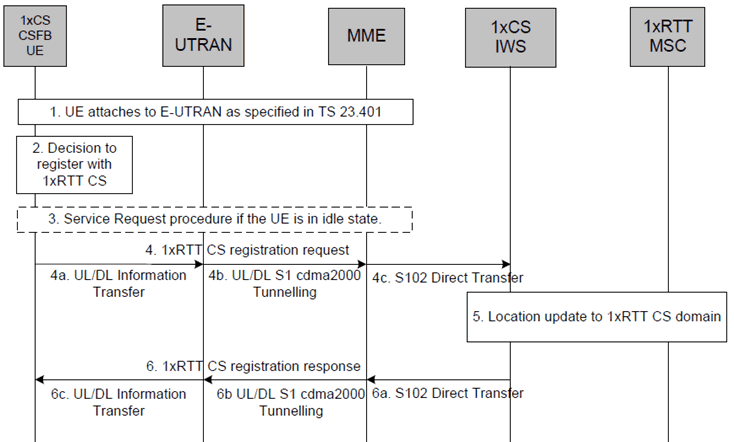Content for TS 23.272 Word version: 19.1.0
1…
4…
5…
5.4…
6…
6.3
6.4…
7…
7.3
7.4…
7.5a…
8…
8.2.4a…
8.3…
8.4…
B…
B.2…
B.2.2…
B.2.3a…
B.2.3a.4…
B.2.4…
B.3…
C…
C.8…
B.2 Procedures p. 74
B.2.1 Mobility Management p. 74
B.2.1.1 1x RTT CS Pre-Registration over EPS Procedure p. 74
This clause describes how the UE in an E-UTRAN system establishes and maintains pre-registration in the 1xCS system.

Step 1.
If the triggers for 1xCS registration change over time, the UE (both in idle or connected state), uses this information to update the 1xCS registration via the tunnel.
The UE attaches to E-UTRAN as specified in TS 23.401. The UE includes an indication of enhanced CS fallback to 1xRTT and may also include concurrent 1xRTT and HRPD PS session handling capabilities as part of the UE radio capabilities.
If the UE is a service user with subscription to 1x priority service in the 1xRTT CS domain, the UE's EPS subscription contains MPS CS priority.
Step 2.
Based on a radio layer trigger (e.g. an indication from the E-UTRAN when the UE is in connected state or an indication over the broadcast channel), the UE decides to register with the 1xRTT CS domain.
Step 3.
If the UE is in idle state, in order to create a signalling connection with the MME, it performs the Service Request procedure.
Step 4.
The UE generates a 1xRTT CS registration request.
Step 4a.
The 1xRTT CS message is transferred from the UE to E-UTRAN.
Step 4b.
E-UTRAN forwards the 1xRTT CS message to the MME including the CDMA2000 Reference Cell ID.
Step 4c.
The MME selects a 1xCS IWS node based on the CDMA2000 Reference Cell ID. The IMSI is used to distinguish S102 signalling transactions belonging to different UEs. The MME sends a S102 Direct Transfer message (IMSI, 1xCS message) to the 1xCS IWS node.
Step 5.
1xRTT CS registration is then performed by the 1xCS IWS node based on 3GPP2 A.S0008 [16].
Step 6a.
1xRTT CS registration response is tunnelled back to the MME in a S102 Direct Transfer message (IMSI, 1xCS message).
Step 6b.
The MME forwards the 1xRTT CS message to the E-UTRAN.
Step 6c.
The E-UTRAN forwards the 1xRTT CS message to the UE.
B.2.1.2 S102 Tunnel Redirection p. 75
S102 Tunnel Redirection Procedure is used when the UE perform Tracking Area Update with MME change while the UE is registered with the 1xRTT CS domain as described in clause B.2.1.1 and the S102 session exists between the MME and the 1xCS IWS.
The detail procedure for the idle case is depicted as Figure B.2.1.2-1.

Figure B.2.1.2-1: S102 tunnel redirection during TAU with MME change
(⇒ copy of original 3GPP image)
(⇒ copy of original 3GPP image)
Step 1.
The detailed procedure for the active case is depicted as Figure B.2.1.2-2.
UE performs 1x-registration over the source MME while in ECM-CONNECTED state, followed by transition to ECM-IDLE state. The S102 tunnel exists between the source MME and the 1xCS IWS.
Step 2.
TAU procedure with MME change as described in TS 23.401, Figure 5.3.3.1-1, up to and including the step where the target MME receives Update Location Ack from the HSS, is executed. The 1xCS IWS ID is transferred to the target MME via the Context Response message.
Step 3.
The target MME sends S102 Redirection Command message to the 1xCS IWS. After receiving this message, the 1xCS IWS associates the S102 tunnel for this specific UE with the target MME. Then the 1xCS IWS releases any context associated with the source MME.
Step 4.
In response to the S102 Redirection Command message, the 1xCS IWS sends a S102 Redirection Ack message to the target MME.
Step 5.
The TAU procedure is completed.

Figure B.2.1.2-2: S102 tunnel redirection during inter-eNodeB handover with MME relocation
(⇒ copy of original 3GPP image)
(⇒ copy of original 3GPP image)
Step 1.
UE performs 1x-registration over the source MME while in ECM-CONNECTED state. The S102 tunnel exists between the source MME and the 1xCS IWS.
Step 2.
Inter-eNodeB handover with MME relocation procedure as described in TS 23.401, Figure 5.5.1.2.2-1, steps prior to TAU, is executed. The 1xCS IWS ID is transferred to the target MME via the Forward Relocation Request message.
Step 3.
The target MME sends S102 Redirection Command message to the 1xCS IWS. After receiving this message, the 1xCS IWS associates the S102 tunnel with the target MME. Then the 1xCS IWS releases any context associated with the source MME.
Step 4.
In response to the S102 Redirection Command message, the 1xCS IWS sends a S102 Redirection Ack message to the target MME.
Step 5.
The TAU procedure occurs.
B.2.1.3 UE-initiated Detach Procedure |R9| p. 76
If a 1xRTT CS Fallback UE, pre-registered to the 1xRTT CS system, initiates the detach procedure in E-UTRAN access due to switch off and the UE is required to perform a "power-down registration" in the 1xRTT CS system (see C.S0005-A [32]), the UE shall first perform the "power-down registration" procedure with the 1xRTT CS system via the S102 tunnel, before initiating the detach procedure in E-UTRAN access as specified in TS 23.401.
A 1xCSF UE, pre-registered to the 1xCS system, performing detach due to reasons other than switch off is not required to perform "power-down registration" with the 1xCS system prior to performing the detach procedure in E-UTRAN.